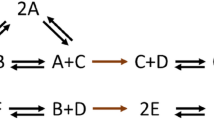Abstract
The criterion of minimum intermediate concentrations in steady states is suggested to be of essential relevance in the evolution of biochemical reaction networks. This extremum principle is phrased in two different ways, firstly in terms of total osmolarity of intermediates and, secondly, as a multiple criterion problem. The relationships between the two problems are elucidated and a solving method for the latter is then given. It turns out that in each optimal state, the network can be subdivided into a slow and a fast subsystem. The notion of convex conservation relations is introduced and the implications of such relations for the optimization problem are investigated.
Similar content being viewed by others
References
1.Atkinson, D. E.: Limitation of metabolite concentrations and the conservation of solvent capacity in the living cell. Curr. Top. Cell. Regul. 1, 29–43 (1969)
Chernikov, S. N.: Linear inequalities (in Russian). Moscow: Nauka 1968. German translation, Berlin: Deutscher Verlag der Wissenschaften 1971
Clarke, B. L.: Stability of complex reaction networks. In: Prigogine, I., Rice, S. A. (eds.) Advances in chemical physics, vol. 43, pp. 1–216. New York: Wiley 1980
Dibrov, B. F., Zhabotinsky, A. M., Kholodenko, B. N.: Dynamic stability of steady states and static stabilization in unbranched metabolic pathways. J. Math. Biol. 15, 51–64 (1982)
Geoffrion, A. M.: Proper efficiency and the theory of vector maximization. J. Math. Anal. Appl. 22, 618–630 (1968)
Guddat, J.: Parametrische Optimierung und Vektoroptimierung. In: Lommatzsch, K. (ed.): Anwendungen der linearen parametrischen Optimierung, pp. 54–75. Berlin: Akademie-Verlag 1979
Heinrich, R., Holzhiitter, H.-G., Schuster, S.: A theoretical approach to the evolution and structural design of enzymatic networks. Bull. Math. Biol. 49, 539–595 (1987)
Heinrich, R., Rapoport, S. M., Rapoport, T. A.: Metabolic regulation and mathematical models. Prog. Biophys. Molec. Biol. 32, 1–82 (1977)
Koch, A. L.: Metabolic control through reflexive enzyme action. J. theor. Biol. 15, 75–102 (1967)
Liljenström, H., Blomberg, C.: Site dependent time optimization of protein synthesis with special regard to accuracy. J. theor. Biol. 129, 41–56 (1987)
Majewski, R. A., Domach, M. M.: Consideration of the gain, enzymatic capacity utilization, and response time properties of metabolic networks as a function of operating point and structure. BioSystems 18, 15–22 (1985)
Moelwyn-Hughes, E. A.: Physical chemistry. Oxford: Pergamon 1964
Nožička, F., Guddat, J., Hollatz, H., Bank, B.: Theorie der linearen parametrischen Optimierung. Berlin: Akademie-Verlag 1974
Reder, C.: Metabolic control theory: A structural approach. J. theor. Biol. 135, 175–201 (1988)
Rockafellar, R.: Convex analysis. Princeton: University Press 1970
Rosen, R.: Optimality in biology and medicine. J. Math. Anal. Appl. 119, 203–222 (1986)
Savageau, M.: Biochemical systems analysis. Reading, Mass.: Addison-Wesley 1976
Sawaragi, Y., Nakayama, H., Tanino, T.: Theory of multiobjective optimization. Orlando: Academic Press 1985
Schauer, M., Heinrich, R.: Quasi-steady-state approximation in the mathematical modeling of biochemical reaction networks. Math. Biosci. 65, 155–171 (1983)
Schuster, S.: Unpublished results, available on request
Schuster, S., Heinrich, R.: Time hierarchy in enzymatic reaction chains resulting from optimality principles. J. theor. Biol. 129, 189–209 (1987)
Schuster, S., Schuster, R.: Detecting strictly detailed balanced subnetworks in open chemical reaction networks. J. Math. Chem., in press
Schuster, S., Schuster, R., Heinrich, R.: Minimization of intermediate concentrations as a suggested optimality principle for biochemical networks. II. Time hierarchy, enzymatic rate laws, and erythrocyte metabolism. J. Math. Biol. 29, 443–455 (1991)
Stoer, J., Witzgall, C.: Convexity and optimization in finite dimensions I. Berlin Heiderlberg New York: Springer 1970
Waley, S. G.: A note on the kinetics of multi-enzyme systems. Biochem. J. 91, 514–517 (1965)
Zeleny, M.: Linear multiobjective programming. Berlin Heidelberg New York: Springer 1974
Author information
Authors and Affiliations
Rights and permissions
About this article
Cite this article
Schuster, S., Heinrich, R. Minimization of intermediate concentrations as a suggested optimality principle for biochemical networks. J. Math. Biol. 29, 425–442 (1991). https://doi.org/10.1007/BF00160470
Received:
Revised:
Issue Date:
DOI: https://doi.org/10.1007/BF00160470




